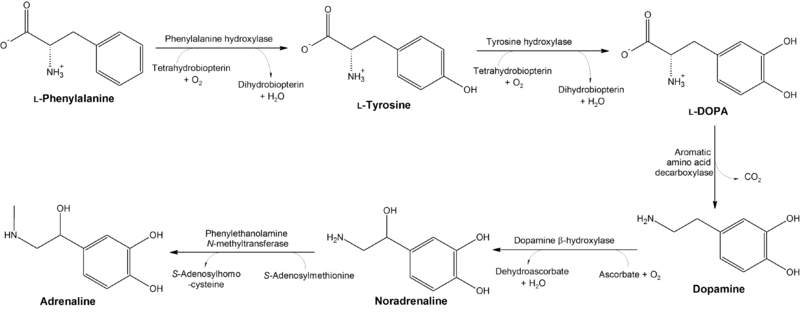Tyrosine
 Skeletal formula of L-tyrosine
| |||
 L-Tyrosine at physiological pH
| |||
| |||
| Names | |||
|---|---|---|---|
| IUPAC name
(S)-Tyrosine
| |||
| Other names
L-2-Amino-3-(4-hydroxyphenyl)propanoic acid
| |||
| Identifiers | |||
| |||
3D model (JSmol)
|
|||
| ChEBI | |||
| ChEMBL | |||
| ChemSpider | |||
| DrugBank | |||
| ECHA InfoCard | 100.000.419 | ||
| KEGG | |||
PubChem CID
|
|||
| UNII | |||
CompTox Dashboard (EPA)
|
|||
| |||
| |||
| Properties | |||
| C9H11NO3 | |||
| Molar mass | 181.191 g·mol−1 | ||
| Appearance | white solid | ||
| .0453 g/100 mL | |||
| -105.3·10−6 cm3/mol | |||
| Hazards | |||
| NFPA 704 (fire diamond) | |||
| Supplementary data page | |||
| Tyrosine (data page) | |||
Except where otherwise noted, data are given for materials in their standard state (at 25 °C [77 °F], 100 kPa).
| |||
L-Tyrosine or tyrosine (symbol Tyr or Y)[2] or 4-hydroxyphenylalanine is one of the 20 standard amino acids that are used by cells to synthesize proteins. It is a conditionally essential amino acid with a polar side group. The word "tyrosine" is from the Greek tyrós, meaning cheese, as it was first discovered in 1846 by German chemist Justus von Liebig in the protein casein from cheese.[3][4] It is called tyrosyl when referred to as a functional group or side chain. While tyrosine is generally classified as a hydrophobic amino acid, it is more hydrophilic than phenylalanine.[5] It is encoded by the codons UAC and UAU in messenger RNA.
The one-letter symbol Y was assigned to tyrosine for being alphabetically nearest of those letters available. Note that T was assigned to the structurally simpler threonine, U was avoided for its similarity with V for valine, W was assigned to tryptophan, while X was reserved for undetermined or atypical amino acids.[6] The mnemonic tYrosine was also proposed.[7]
Functions
[edit]Aside from being a proteinogenic amino acid, tyrosine has a special role by virtue of the phenol functionality. Its hydroxy group is able to form the ester linkage, with phosphate in particular. Phosphate groups are transferred to tyrosine residues by way of protein kinases. This is one of the post-translational modifications. Phosphorylated tyrosine occurs in proteins that are part of signal transduction processes.
Similar functionality is also presented in serine and threonine, whose side chains have a hydroxy group, but are alcohols. Phosphorylation of these three amino acids' moieties (including tyrosine) creates a negative charge on their ends, that is greater than the negative charge of the only negatively charged aspartic and glutamic acids. Phosphorylated proteins keep these same properties—which are useful for more reliable protein-protein interactions—by means of phosphotyrosine, phosphoserine and phosphothreonine.[8]
Binding sites for a signalling phosphoprotein may be diverse in their chemical structure.[9]
Phosphorylation of the hydroxyl group can change the activity of the target protein, or may form part of a signaling cascade via SH2 domain binding.[10]
A tyrosine residue also plays an important role in photosynthesis. In chloroplasts (photosystem II), it acts as an electron donor in the reduction of oxidized chlorophyll. In this process, it loses the hydrogen atom of its phenolic OH-group. This radical is subsequently reduced in the photosystem II by the four core manganese clusters.[11]
Dietary requirements and sources
[edit]The Dietary Reference Intake for tyrosine is usually estimated together with phenylalanine. It varies depending on an estimate method, however the ideal proportion of these two amino acids is considered to be 60:40 (phenylalanine:tyrosine) as a human body has such composition.[12] Tyrosine, which can also be synthesized in the body from phenylalanine, is found in many high-protein food products such as meat, fish, cheese, cottage cheese, milk, yogurt, peanuts, almonds, pumpkin seeds, sesame seeds, soy protein and lima beans.[13][14] For example, the white of an egg has about 250 mg per egg,[15] while beef, lamb, pork, tuna, salmon, chicken, and turkey contain about 500–1000 mg per 3 ounces (85 g) portion.[15][16]
Biosynthesis
[edit]
In plants and most microorganisms, tyrosine is produced via prephenate, an intermediate on the shikimate pathway. Prephenate is oxidatively decarboxylated with retention of the hydroxyl group to give p-hydroxyphenylpyruvate, which is transaminated using glutamate as the nitrogen source to give tyrosine and α-ketoglutarate.
Mammals synthesize tyrosine from the essential amino acid phenylalanine (Phe), which is derived from food. The conversion of Phe to Tyr is catalyzed by the enzyme phenylalanine hydroxylase, a monooxygenase. This enzyme catalyzes the reaction causing the addition of a hydroxyl group to the end of the 6-carbon aromatic ring of phenylalanine, such that it becomes tyrosine.
Metabolism
[edit]
Phosphorylation and sulfation
[edit]Some of the tyrosine residues can be tagged (at the hydroxyl group) with a phosphate group (phosphorylated) by protein kinases. In its phosphorylated form, tyrosine is called phosphotyrosine. Tyrosine phosphorylation is considered to be one of the key steps in signal transduction and regulation of enzymatic activity. Phosphotyrosine can be detected through specific antibodies. Tyrosine residues may also be modified by the addition of a sulfate group, a process known as tyrosine sulfation.[17] Tyrosine sulfation is catalyzed by tyrosylprotein sulfotransferase (TPST). Like the phosphotyrosine antibodies mentioned above, antibodies have recently been described that specifically detect sulfotyrosine.[18]
Precursor to neurotransmitters and hormones
[edit]In dopaminergic cells in the brain, tyrosine is converted to L-DOPA by the enzyme tyrosine hydroxylase (TH). TH is the rate-limiting enzyme involved in the synthesis of the neurotransmitter dopamine. Dopamine can then be converted into other catecholamines, such as norepinephrine (noradrenaline) and epinephrine (adrenaline).
The thyroid hormones triiodothyronine (T3) and thyroxine (T4) in the colloid of the thyroid are also derived from tyrosine.
Precursor to other compounds
[edit]The latex of Papaver somniferum, the opium poppy, has been shown to convert tyrosine into the alkaloid morphine and the bio-synthetic pathway has been established from tyrosine to morphine by using Carbon-14 radio-labelled tyrosine to trace the in-vivo synthetic route.[22]Tyrosine ammonia lyase (TAL) is an enzyme in the natural phenols biosynthesis pathway. It transforms L-tyrosine into p-coumaric acid. Tyrosine is also the precursor to the pigment melanin. Tyrosine (or its precursor phenylalanine) is needed to synthesize the benzoquinone structure which forms part of coenzyme Q10.[23][24]
Degradation
[edit]
The decomposition of L-tyrosine (syn. para-hydroxyphenylalanine) begins with an α-ketoglutarate dependent transamination through the tyrosine transaminase to para-hydroxyphenylpyruvate. The positional description para, abbreviated p, mean that the hydroxyl group and side chain on the phenyl ring are across from each other (see the illustration below).
The next oxidation step catalyzes by p-hydroxyphenylpyruvate dioxygenase and splitting off CO2 homogentisate (2,5-dihydroxyphenyl-1-acetate).[25] In order to split the aromatic ring of homogentisate, a further dioxygenase, homogentisate 1,2-dioxygenase is required. Thereby, through the incorporation of a further O2 molecule, maleylacetoacetate is created.
Fumarylacetoacetate is created by maleylacetoacetate cis-trans-isomerase through rotation of the carboxyl group created from the hydroxyl group via oxidation. This cis-trans-isomerase contains glutathione as a coenzyme. Fumarylacetoacetate is finally split by the enzyme fumarylacetoacetate hydrolase through the addition of a water molecule.
Thereby fumarate (also a metabolite of the citric acid cycle) and acetoacetate (3-ketobutyroate) are liberated. Acetoacetate is a ketone body, which is activated with succinyl-CoA, and thereafter it can be converted into acetyl-CoA, which in turn can be oxidized by the citric acid cycle or be used for fatty acid synthesis.
Phloretic acid is also a urinary metabolite of tyrosine in rats.[26]
Ortho- and meta-tyrosine
[edit]
Three structural isomers of L-tyrosine are known. In addition to the common amino acid L-tyrosine, which is the para isomer (para-tyr, p-tyr or 4-hydroxyphenylalanine), there are two additional regioisomers, namely meta-tyrosine (also known as 3-hydroxyphenylalanine, L-m-tyrosine, and m-tyr) and ortho-tyrosine (o-tyr or 2-hydroxyphenylalanine), that occur in nature. The m-tyr and o-tyr isomers, which are rare, arise through non-enzymatic free-radical hydroxylation of phenylalanine under conditions of oxidative stress.[27][28]
Medical use
[edit]Tyrosine is a precursor to neurotransmitters and increases plasma neurotransmitter levels (particularly dopamine and norepinephrine),[29] but has little if any effect on mood in normal subjects.[30][31][32]
A 2015 systematic review found that "tyrosine loading acutely counteracts decrements in working memory and information processing that are induced by demanding situational conditions such as extreme weather or cognitive load" and therefore "tyrosine may benefit healthy individuals exposed to demanding situational conditions".[33]
Industrial synthesis
[edit]L-tyrosine is used in pharmaceuticals, dietary supplements, and food additives. Two methods were formerly used to manufacture L-tyrosine. The first involves the extraction of the desired amino acid from protein hydrolysates using a chemical approach. The second utilizes enzymatic synthesis from phenolics, pyruvate, and ammonia through the use of tyrosine phenol-lyase.[34] Advances in genetic engineering and the advent of industrial fermentation have shifted the synthesis of L-tyrosine to the use of engineered strains of E. coli.[35][34]
See also
[edit]- Albinism
- Alkaptonuria
- Betalain
- Iodinated tyrosine derivatives
- Pauly reaction
- Tyramine
- Tyrosine sulfation
- Tyrosinemia
References
[edit]- ^ a b Frey MN, Koetzle TF, Lehmann MS, Hamilton WC (1973). "Precision neutron diffraction structure determination of protein and nucleic acid components. X. A comparison between the crystal and molecular structures of L-tyrosine and L-tyrosine hydrochloride". J. Chem. Phys. 58 (6): 2547–2556. Bibcode:1973JChPh..58.2547F. doi:10.1063/1.1679537.
- ^ "Nomenclature and Symbolism for Amino Acids and Peptides". IUPAC-IUB Joint Commission on Biochemical Nomenclature. 1983. Archived from the original on 9 October 2008. Retrieved 5 March 2018.
- ^ "Tyrosine". The Columbia Electronic Encyclopedia, 6th ed. Infoplease.com — Columbia University Press. 2007. Retrieved 2008-04-20.
- ^ Harper D (2001). "Tyrosine". Online Etymology Dictionary. Retrieved 2008-04-20.
- ^ "Amino Acids - Tyrosine". www.biology.arizona.edu. Retrieved 2018-01-31.
- ^ "IUPAC-IUB Commission on Biochemical Nomenclature A One-Letter Notation for Amino Acid Sequences". Journal of Biological Chemistry. 243 (13): 3557–3559. 10 July 1968. doi:10.1016/S0021-9258(19)34176-6.
- ^ Saffran M (April 1998). "Amino acid names and parlor games: from trivial names to a one-letter code, amino acid names have strained students' memories. Is a more rational nomenclature possible?". Biochemical Education. 26 (2): 116–118. doi:10.1016/S0307-4412(97)00167-2.
- ^ Hunter T (2012-09-19). "Why nature chose phosphate to modify proteins". Philosophical Transactions of the Royal Society B: Biological Sciences. 367 (1602): 2513–2516. doi:10.1098/rstb.2012.0013. ISSN 0962-8436. PMC 3415839. PMID 22889903.
- ^ Lu ZC, Jiang F, Wu YD (2021-12-11). "Phosphate binding sites prediction in phosphorylation-dependent protein-protein interactions". Bioinformatics. 37 (24): 4712–4718. doi:10.1093/bioinformatics/btab525. ISSN 1367-4811. PMID 34270697.
- ^ Liu BA, Nash PD (2012-09-19). "Evolution of SH2 domains and phosphotyrosine signalling networks". Philosophical Transactions of the Royal Society B: Biological Sciences. 367 (1602): 2556–2573. doi:10.1098/rstb.2012.0107. ISSN 0962-8436. PMC 3415846. PMID 22889907.
- ^ Barry BA (January 2015). "Reaction dynamics and proton coupled electron transfer: studies of tyrosine-based charge transfer in natural and biomimetic systems". Biochimica et Biophysica Acta (BBA) - Bioenergetics. 1847 (1): 46–54. doi:10.1016/j.bbabio.2014.09.003. ISSN 0006-3002. PMID 25260243.
- ^ Pencharz PB, Hsu JW, Ball RO (June 2007). "Aromatic amino acid requirements in healthy human subjects". The Journal of Nutrition. 137 (6 Suppl 1): 1576S–1578S, discussion 1597S-1598S. doi:10.1093/jn/137.6.1576S. PMID 17513429.
- ^ Nutient Ranking Tool. MyFoodData.com. https://tools.myfooddata.com/nutrient-ranking-tool/tyrosine/all/highest
- ^ "Tyrosine". University of Maryland Medical Center. Archived from the original on 2013-06-04. Retrieved 2011-03-17.
- ^ a b Top 10 Foods Highest in Tyrosine
- ^ Nutient Ranking Tool. MyFoodData.com. https://tools.myfooddata.com https://tools.myfooddata.com/nutrient-ranking-tool/tyrosine/meats/highest/ounces/common/no
- ^ Hoffhines AJ, Damoc E, Bridges KG, Leary JA, Moore KL (December 2006). "Detection and purification of tyrosine-sulfated proteins using a novel anti-sulfotyrosine monoclonal antibody". The Journal of Biological Chemistry. 281 (49): 37877–87. doi:10.1074/jbc.M609398200. PMC 1764208. PMID 17046811.
- ^ Kanan Y, Hamilton RA, Sherry DM, Al-Ubaidi MR (December 2012). "Focus on molecules: sulfotyrosine". Experimental Eye Research. 105: 85–6. doi:10.1016/j.exer.2012.02.014. PMC 3629733. PMID 22406006.
- ^ Broadley KJ (March 2010). "The vascular effects of trace amines and amphetamines". Pharmacology & Therapeutics. 125 (3): 363–375. doi:10.1016/j.pharmthera.2009.11.005. PMID 19948186.
- ^ Lindemann L, Hoener MC (May 2005). "A renaissance in trace amines inspired by a novel GPCR family". Trends in Pharmacological Sciences. 26 (5): 274–281. doi:10.1016/j.tips.2005.03.007. PMID 15860375.
- ^ Wang X, Li J, Dong G, Yue J (February 2014). "The endogenous substrates of brain CYP2D". European Journal of Pharmacology. 724: 211–218. doi:10.1016/j.ejphar.2013.12.025. PMID 24374199.
- ^ Battersby AR, Binks R, Harper BJ (1962-01-01). "692. Alkaloid biosynthesis. Part II. The biosynthesis of morphine". Journal of the Chemical Society: 3534–3544. doi:10.1039/JR9620003534. ISSN 0368-1769.
- ^ Bentinger M, Tekle M, Dallner G (May 2010). "Coenzyme Q--biosynthesis and functions". Biochemical and Biophysical Research Communications. 396 (1): 74–9. doi:10.1016/j.bbrc.2010.02.147. PMID 20494114.
- ^ Acosta MJ, Vazquez Fonseca L, Desbats MA, Cerqua C, Zordan R, Trevisson E, et al. (2016). "Coenzyme Q biosynthesis in health and disease". Biochimica et Biophysica Acta (BBA) - Bioenergetics. 1857 (8): 1079–1085. doi:10.1016/j.bbabio.2016.03.036. PMID 27060254.
- ^ Zea-Rey AV, Cruz-Camino H, Vazquez-Cantu DL, Gutiérrez-García VM, Santos-Guzmán J, Cantú-Reyna C (27 November 2017). "The Incidence of Transient Neonatal Tyrosinemia Within a Mexican Population". Journal of Inborn Errors of Metabolism and Screening. 5: 232640981774423. doi:10.1177/2326409817744230.
- ^ Booth AN, Masri MS, Robbins DJ, Emerson OH, Jones FT, DeEds F (1960). "Urinary phenolic acid metabolities of tyrosine". Journal of Biological Chemistry. 235 (9): 2649–2652. doi:10.1016/S0021-9258(19)76930-0.
- ^ Molnár GA, Wagner Z, Markó L, Kó Szegi T, Mohás M, Kocsis B, et al. (November 2005). "Urinary ortho-tyrosine excretion in diabetes mellitus and renal failure: evidence for hydroxyl radical production". Kidney International. 68 (5): 2281–7. doi:10.1111/j.1523-1755.2005.00687.x. PMID 16221230.
- ^ Molnár GA, Nemes V, Biró Z, Ludány A, Wagner Z, Wittmann I (December 2005). "Accumulation of the hydroxyl free radical markers meta-, ortho-tyrosine and DOPA in cataractous lenses is accompanied by a lower protein and phenylalanine content of the water-soluble phase". Free Radical Research. 39 (12): 1359–66. doi:10.1080/10715760500307107. PMID 16298866. S2CID 31154432.
- ^ Rasmussen DD, Ishizuka B, Quigley ME, Yen SS (October 1983). "Effects of tyrosine and tryptophan ingestion on plasma catecholamine and 3,4-dihydroxyphenylacetic acid concentrations". The Journal of Clinical Endocrinology and Metabolism. 57 (4): 760–3. doi:10.1210/jcem-57-4-760. PMID 6885965.
- ^ Leathwood PD, Pollet P (1982). "Diet-induced mood changes in normal populations". Journal of Psychiatric Research. 17 (2): 147–54. doi:10.1016/0022-3956(82)90016-4. PMID 6764931.
- ^ Deijen JB, Orlebeke JF (1994). "Effect of tyrosine on cognitive function and blood pressure under stress". Brain Research Bulletin. 33 (3): 319–23. doi:10.1016/0361-9230(94)90200-3. PMID 8293316. S2CID 33823121.
- ^ Lieberman HR, Corkin S, Spring BJ, Wurtman RJ, Growdon JH (August 1985). "The effects of dietary neurotransmitter precursors on human behavior". The American Journal of Clinical Nutrition. 42 (2): 366–70. doi:10.1093/ajcn/42.2.366. PMID 4025206.
- ^ Jung SE, Hase A, ann het Rot M (2015). "Behavioral and cognitive effects of tyrosine intake in healthy human adults". Pharmacology Biochemistry and Behavior. 133: 1–6. doi:10.1016/j.pbb.2015.03.008. PMID 25797188. S2CID 30331663.
- ^ a b Lütke-Eversloh T, Santos CN, Stephanopoulos G (December 2007). "Perspectives of biotechnological production of L-tyrosine and its applications". Applied Microbiology and Biotechnology. 77 (4): 751–62. doi:10.1007/s00253-007-1243-y. PMID 17968539. S2CID 23088822.
- ^ Chavez-Bejar M, Baez-Viveros J, Martinez A, Bolivar F, Gosset G (2012). "Biotechnological production of L-tyrosine and derived compounds". Process Biochemistry. 47 (7): 1017–1026. doi:10.1016/j.procbio.2012.04.005.





